Tupolev Tu-22M
| Tu-22M | |
|---|---|
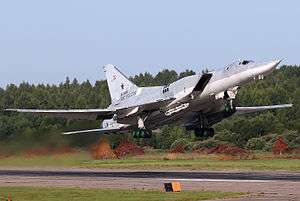 | |
| A Russian Air Force Tu-22M3 | |
| Role | Strategic bomber/Maritime strike |
| Manufacturer | Tupolev |
| First flight | 30 August 1969 |
| Introduction | 1972 |
| Status | In service |
| Primary users | Soviet Air Forces (historical) Russian Air Force Ukrainian Air Force Indian Navy (historical) |
| Produced | 1967–1997[1] |
| Number built | 497 |
| Developed from | Tupolev Tu-22 |
The Tupolev Tu-22M (Russian: Туполев Ту-22М; NATO reporting name: Backfire) is a supersonic, variable-sweep wing, long-range strategic and maritime strike bomber developed by the Tupolev Design Bureau. According to some sources, the bomber was believed to be designated Tu-26 at one time. During the Cold War, the Tu-22M was operated by the Soviet Air Force (VVS) in a strategic bombing role, and by the Soviet Naval Aviation (Aviacija Vojenno-Morskogo Flota, AVMF) in a long-range maritime anti-shipping role.[2] Significant numbers remain in service with the Russian Air Force, and as of 2014 more than 100 Tu-22Ms are in use.[3]
Development
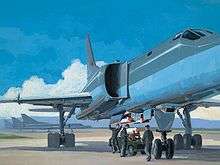
In 1962, with the introduction of the Tu-22, it became increasingly clear that the aircraft was considerably inadequate in its role as a bomber. In addition to widespread unserviceability and maintenance issues, the Tu-22’s handling characteristics proved to be dangerous. Its landing speed was some 100 km/h (60 mph) greater than previous bombers and it had a tendency to pitch up and strike its tail upon landing. It was difficult to fly, and had poor all-round visibility.[4] In 1962, Tupolev commenced work on major update of the Tu-22. Initially, the bureau planned to add a variable-sweep wing and uprated engines into the updated design. The design was tested at TsAGI’s wind tunnels at Zhukovsky.[4]
During this time, Sukhoi, traditionally a designer of fighter aircraft, developed the T-4, a four-engine titanium aircraft with canards. A response to the XB-70, it was to have a cruise speed of 3,200 km/h (2,000 mph), requiring a massive research effort in order to develop the requisite technologies. Not to be outdone, Tupolev, whose expertise is with bombers, offered the Soviet Air Force (Voyenno-Vozdushnye Sily, VVS) a massively-updated version of the Tu-22.[5]
Compared to the T-4, it was an evolutionary design, and thus its appeal laid in its simplicity and low cost. However, the Soviet government was sceptical about the need to approve the development of a replacement aircraft so soon after the Tu-22 had just entered service.[6] The Air Force and Tupolev, in order to save face with regards to the Tu-22’s operational deficiencies and to stave off criticisms from the ICBM lobby, agreed to pass off the design as an update of the Tu-22 in their discussions with the government. The aircraft was designated Tu-22M, given the OKB code "Aircraft 45", and an internal designation of "AM". Their effort was successful as the government approved the design on 28 November 1967, and decreed the development of the aircraft's main weapon, the Kh-22.[7] The T-4 itself would make its first flight in 1972, but was later cancelled.[5]
US intelligence had been aware of the existence of the aircraft since 1969, and the first satellite photograph of the bomber would be taken in 1970. The existence of the aircraft was a shock to US intelligence as Nikita Kruschev, who had been the Soviet premier up to 1964, was adamant that ICBMs would render the bomber obsolete.[8]
As in the case of its contemporaries, the MiG-23 and Su-17 projects, the advantages of variable-sweep wing (or "swing wing") seemed attractive, allowing a combination of short take-off performance, efficient cruising, and good high-speed, low-level flight. The result was a new swing wing aircraft named Samolyot 145 (Aeroplane 145), derived from the Tupolev Tu-22, with some features borrowed from the abortive Tu-98. The Tu-22M was based on the Tu-22's weapon system and used its Kh-22 missile. The Tu-22M designation was used to help get approval for the bomber within the Soviet military and government system.[9]
The Tu-22M designation was used by the Soviet Union during the SALT II arms control negotiations, creating the impression that it was a modification of the Tu-22. Some suggested that the designation was deliberately deceptive, and intended to hide the Tu-22M's performance. Other sources suggest the "deception" was internal to make it easier to get budgets approved. According to some sources, the Backfire-B/C production variants were believed to be designated Tu-26 by Russia, although this is disputed by many others. The US State and Defense Departments have used the Tu-22M designation for the Backfire.[10]
Production of all Tu-22M variants totalled 497 including pre-production aircraft.[2]
In 2014, Russian aerospace expert Piotr Butowski estimated there were seven squadrons of Tu-22Ms in service, each with approximately 10 aircraft, stationed at three airbases; 40 at Belaya airbase in southeastern Siberia, 28 at Shaykovka airbase southwest of Moscow, and 10 at Dyagilevo airbase in Ryazan southeast of Moscow which serves as the training unit for the bomber. With the deletion of the aircraft's in-flight refueling capability due to the START I treaty, the Tu-22M's internal fuel capacity limits its operational range from its home bases to only around Russia's immediate sphere of influence.[11]
Operational history
The two prototypes Tu-22M0 were delivered to Long Range Aviation’s 42nd Combat Training Centre at Dyagilevo air base, near Ryazan, in February 1973. The aircraft began practice sorties in March. Within 20 days of the aircraft’s delivery, the air and ground crew at the air base had received their type ratings; this was helped by their earlier training at Tupolev, the Gromov Flight Research Institute and the Kazan plant.[12] In June that year, the aircraft were demonstrated to Soviet government officials, destroying tanks and armoured personnel carriers.[12]
The Tu-22M was first unveiled in 1980 during the aircraft’s participation in a major Warsaw Pact exercise. During the exercise, naval Tu-22M2s conducted anti-ship operations by mining parts of the Baltic Sea to simulate an amphibious landing. The exercise was extensively covered by the press and TV media.[13][14] In June 1981, four Tu-22Ms were intercepted and photographed by Norwegian aircraft flying over the Norwegian Sea.[15]
The first simulated attack by the Tu-22M against a NATO carrier group occurred between 30 September and 1 October 1982. Eight aircraft locked onto the U.S. task forces of USS Enterprise and USS Midway which were operating in the North Pacific. They came within 120 mi (200 km) of the task forces. The reaction of the U.S. Navy was thought to have been restrained during this event so as to allow the observation of the Tu-22M's tactics.[16] The bomber also made attempts to test Japan's air defense boundary on several occasions.
The Tu-22M was first used in combat in Afghanistan. It was deployed December 1987 to January 1988, during which the aircraft flew strike missions in support of the Soviet Army's attempt to relieve the Mujahideens' siege against the city of Khost. Two squadrons of aircraft from the 185th GvBAP based at Poltava were deployed to Maryy-2 air base in Turkmenistan. Capable of dropping large tonnages of conventional ordnance, the aircraft bombed enemy forts, bases and material supplies.[17] In October 1988, the aircraft was again deployed against the Mujahideen. Sixteen Tu-22M3s were used to provide cover to Soviet forces that were pulling out of the country. The Tu-22Ms were tasked with destroying paths of access to Soviet forces, attacking enemy forces at night to prevent regrouping, and to attack incoming supplies from Iran and Pakistan. Working alongside 30 newly arrived MiG-27s, the aircraft also from flew missions aimed at relieving the besieged city of Kandahar.[18][19] The aircraft had its last Afghan operation in January 1989 at Salang pass.[20]
The Tu-22M suffered from widespread maintenance issues during its service with the Soviet forces. These stemmed from poor manufacturing quality. The engines and airframes in particular had low service lives.[21] The Air Force at one point sought to have Tupolev prosecuted for allegedly rushing the inadequate designs of the Tu-22M and the Tu-160 into service.[22] This was compounded by the government bureaucracy, which hampered the provision of spare parts to allow the servicing of the Tu-22M. With some aircraft grounded for up to six months, the mission-capable rate of the aircraft in August 1991 hovered around 30–40%.[21][23]
At the time of the dissolution of the Soviet Union, 370 remained in Commonwealth of Independent States service. Production ended in 1993.
The Russian Federation used the Tu-22M3 in combat in Chechnya during 1995, performing strikes near Grozny.[2]
In August 2007, the Tu-22M and the Tu-95 began conducting long-range patrolling, for the first time since 1992.[24][25]
The Russian military acknowledged the loss of a Tu-22MR recon aircraft to Georgian air defences early in the 2008 South Ossetia war.[26][27] One of its crew members was captured (Major Vyacheslav Malkov), two others were killed and the crew commander, Lt. Col. Aleksandr Koventsov, was missing in action[28] as late as November 2011.[29]
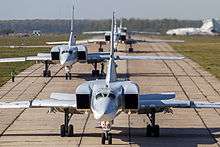
On Good Friday night, 29 March 2013, two Tu-22M3 bombers were flying in international airspace in a simulated attack on Sweden. The Swedish air defense failed to respond.[30][31] Two Tu-22Ms flew supersonic over the Baltic Sea on 24 March 2015.[32] Two Tu-22Ms approached Öland in international airspace on 21 May 2015. The Swedish Air Force sent two Saab JAS 39 Gripen fighters to mark their presence.[33] On 4 July 2015, two Tu-22Ms approached the Swedish island of Gotland, followed by Swedish and other fighter aircraft. The Russian bombers did not enter Swedish territory.[34]
On 17 November 2015, as part of its air campaign in Syria, Russia used 12 Tu-22M3 bombers to hit targets in Syria, along with cruise missiles fired from the Mediterranean and Tu-95 and Tu-160 strategic bombers.[35][36] From 22 until 31 January 2016, Tu-22M3s reportedly conducted 42 sorties in the vicinity of Deir ez-Zor city, Syria.[37][38] On the morning of 12 July 2016, six Tu-22M3 bombers carried out a concentrated attack using high-explosive ammunition on Daesh targets east of Palmyra, As Sukhnah and Arak.[39] On 14 July, six Tu-22M3 bombers that took off from their base airfields in Russia delivered another massive strike on the newly detected IS facilities in the areas east of Palmyra, as well as in Es Sukhne, Arak and the T-3 oil pumping station in the province of Homs.[40] New raids were conducted on 21 July,[41] 8 August,[42] 11 August,[43] 14 August[44] 2016.
On 16 August 2016, the bombers began to fly missions in Syria using Iran′s Hamedan Airbase.[45]
Export
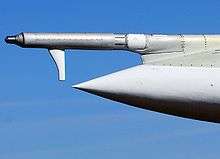
The Tupolev company has sought export customers for the Tu-22M since 1992, with possible customers including Iran, India and the People's Republic of China, but no sales have apparently been made. Unlike the Tu-22 bomber, Tu-22Ms were not exported to Middle East countries that posed a threat to the US military presence in the region.[46] During 2001, India signed a lease-to-buy contract for four Tu-22M aircraft for maritime reconnaissance and strike purposes. At the time, the aircraft were expected to be delivered with Raduga Kh-22 cruise missiles.[47][48][49] The deal was later cancelled.
In January 2013, reports emerged that China had signed a purchase agreement for the production and delivery of 36 Tu-22M3s, under the Chinese designation of H-10, with many components to be manufactured domestically in China under a technology transfer agreement with Russia and Tupolev.[50] Sales of the Russian-built Raduga Kh-22 long-range anti-ship missile and the fleet's intended use as a maritime strike platform have also been speculated upon.[51] Rosoboronexport has reportedly denied any sales or negotiations with China regarding the Tu-22M.[52]
Variants
.jpg)
.jpg)
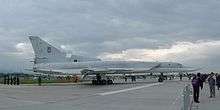
Only nine of the earliest Tu-22M0 pre-production aircraft were produced, followed by nine more Tu-22M1 pilot-production craft in 1971 and 1972. Its NATO reporting name was Backfire-A.
The first major production version, entering production in 1972, was the Tu-22M2 (NATO: Backfire-B), with longer wings and an extensively redesigned, area ruled fuselage (raising the crew complement to four), twin NK-22 engines (215 kN thrust each) with F-4 Phantom II-style intake ramps, and new undercarriage with the main landing gear in the wing glove rather than in large pods. 211 Tu-22M2 were built from 1972 into 1983.[53] The Tu-22M2 had a top speed of Mach 1.65 and was armed most commonly with long-range cruise missiles/anti-ship missiles, typically one or two Raduga Kh-22 anti-shipping missiles.[53] Some Tu-22M2s were later reequipped with more powerful NK-23 engines and redesignated Tu-22M2Ye.
The later Tu-22M3 (NATO: Backfire-C), which first flew in 1977, introduced into operations in 1983[53] had new NK-25 engines with substantially more power, wedge-shaped intake ramps similar to the MiG-25, wings with greater maximum sweep and a recontoured nose housing a new Leninets PN-AD radar and NK-45 nav/attack system, which provides much-improved low-altitude flight. The aerodynamic changes increased its top speed to Mach 2.05 and its range by one third compared to the Tu-22M2.[53] It has a revised tail turret with a single cannon, and provision for an internal rotary launcher for the Raduga Kh-15 missile, similar to the American AGM-69 SRAM. It was nicknamed Troika ('Trio' or third) in Russian service. 268 were built till 1993.[54][55][53]
As built, the Tu-22M included the provision for a retractable probe in the upper part of the nose for aerial refueling. The probe was reportedly removed as a result of the SALT negotiations, because with refueling it was considered an intercontinental range strategic bomber.[56] The probe can be reinstated if needed.[2][57]
Several Tu-22M3s, perhaps 12, were converted to Tu-22M3(R) or Tu-22MR standard with Shompol side looking airborne radar and other ELINT equipment.[2]
Tu-22M3M: Tu-22M3 for RuAF with upgraded avionics and the ability to use precision air-to-surface weapons. Prior to 2020 it is planned to upgrade 30 Tu-22M3 with new hardware components and adapted for the extended range weapons.[58] 5 modernized aircraft entered service in 2015.[59][60][61]
Operators
- Russian Air Force – 93 in service as of December 2010[62]
- Russian Naval Aviation – 58 in use as of December 2010[62]
Former operators
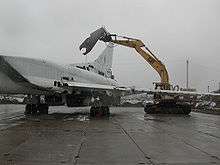
- Ukrainian Air Force
- Ukrainian Naval Aviation
- 1 Tu-22M3 and 1 Tu-22M2 in museums[63]
Specifications (Tu-22M3)
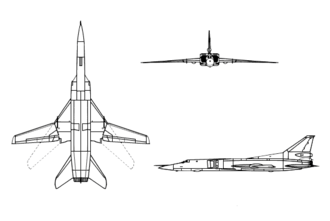
_(2).jpg)

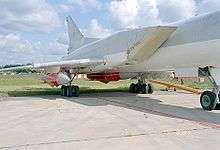
Data from Frawley,[64] Donald,[65] Wilson[66]
General characteristics
- Crew: 4 (pilot, co-pilot, navigator, weapon systems officer)
- Length: 42.4 m (139 ft 4 in)
- Wingspan:
- Spread (20° sweep): 34.28 m (112 ft 6 in)
- Swept (65° sweep): 23.30 m (76 ft 6 in)
- Height: 11.05 m (36 ft 3 in)
- Wing area:
- Spread: 183.6 m² (1,976 ft²)
- Swept: 175.8 m² (1,892 ft²)
- Empty weight: 58,000 kg (128,000 lb)
- Loaded weight: 112,000 kg (246,000 lb)
- Max. takeoff weight: 124,000 kg (273,000 lb) ; 126,400 kg (278,700 lb) for rocket assisted TO
- Powerplant: 2 × Kuznetsov NK-25 turbofans, 247.9 kN (55,100 lbf) each
- Fuel capacity: 54,000 kg (118,800 lb) internally
Performance
- Maximum speed: Mach 1.88 (2,303.08 km/h; 1,243.565 kn; 1,431.07 mph) (2,000 kilometres per hour (Mach 1.6; 1,100 kn; 1,200 mph)) ; at altitude
- Range: 6,800 km (4,200 mi, 3,700 nmi)
- Combat radius: 2,410 km (1,500 mi, 1,300 nmi) with typical weapons load
- Service ceiling: 13,300 m (43,600 ft)
- Rate of climb: 15 m/s (2,950 ft/min)
- Wing loading: 688 kg/m² (147 lb/ft²)
- Thrust/weight: 0.45
Armament
- Guns: 1 × 23-mm GSh-23 cannon in remotely controlled tail turret
- Hardpoints: wing and fuselage pylons and internal weapons bay with a capacity of 24,000 kg (53,000 lb) of
- Up to 3 × Kh-22 missiles in weapons bay and on wing pylons or
- Up to 6 × Kh-15 missiles on a MKU-6-1 rotary launcher in its bomb bay, plus 4 × Raduga Kh-15 missiles on two underwing pylons for a total of 10 missiles per aircraft.
- Various freefall bombs – 69 × FAB-250 or 8 × FAB-1500 might be typical.
The Kh-55 (AS-15 Kent) long-range cruise missile was tested on the Tu-22M[67] but apparently not used in service.
Notable appearances in media
See also
- Related development
- Aircraft of comparable role, configuration and era
References
- Citations
- ↑ "Ту-22М (Ту-22М2/Ту-22МЗ) -дальний бомбардировщик" [Tu-22 m (Tu-22 m 2/TU-22mz)-long-range bomber]. oaokapo.ru (in Russian). Archived from the original on 31 July 2013.
- 1 2 3 4 5 Goebel, Greg. "The Tupolev Tu-22 "Blinder" & Tu-22M 'Backfire'". vectorsite.net. Archived from the original on 5 March 2012.
- ↑ Hoyle, Craig (26 September 2014). "Kings of the swingers: Top 13 swing-wing aircraft". Flightglobal. Archived from the original on 27 September 2014. Retrieved 27 September 2014.
- 1 2 Kandalov & Duffy 1996, p. 124.
- 1 2 Gordon, Rigmant & Komissarov 1999, p. 51.
- ↑ Gordon, Rigmant & Komissarov 1999, pp. 51–2.
- ↑ Gordon, Rigmant & Komissarov 1999, p. 52.
- ↑ Kandalov & Duffy 1996, p. 158.
- ↑ Eden, Paul, ed. Tupolev Tu-22/22M". Encyclopedia of Modern Military Aircraft. London: Amber Books, 2004. ISBN 1-904687-84-9.
- ↑ "Tu-22M BACKFIRE (TUPOLEV)". FAS.org. Retrieved 24 November 2015.
- ↑ Russia’s Backfire Bomber Is Back! - Warisboring.com, 13 June 2014
- 1 2 Gordon, Rigmant & Komissarov 1999, p. 81.
- ↑ Gordon, Rigmant & Komissarov 1999, p. 82.
- ↑ "Military Exercises on Soviet-Bloc TV". New York Times. 14 September 1980. p. A5.
- ↑ "Soviet planes photographed". The Globe and Mail. 15 June 1981. p. 14.
- ↑ "Backfires attack US carriers". Flight International. Surrey, UK: IPC Transport Press. 122 (3837): 1480. 14–20 November 1982. ISSN 0015-3710.
- ↑ Gordon, Rigmant & Komissarov 1999, pp. 83–4.
- ↑ "USSR Uses Backfires, MiG-27s to Attack Afghan Mujahedeen". Aviation Week & Space Technology. New York: Penton Media. 129 (19): 21. 7 November 1988. ISSN 0005-2175.
- ↑ Moseley, Ray (2 November 1988). "Soviets Add Missiles in Afghan War". Chicago Tribune. p. 16.
- ↑ Gordon, Rigmant & Komissarov 1999, p. 84.
- 1 2 Velovich, Alexander (7–13 August 1991). "Spares deficit grounds Tu-22s" (PDF). Flight International. London, UK: Reed Business Information. 140 (4279): 17. ISSN 0015-3710.
- ↑ Velovich, Alexander (6–12 November 1991). "Soviet AF wanted Tupolev prosecuted over Blackjack". Flight International. London, UK: Reed Business Information. 140 (4292): 21. ISSN 0015-3710.
- ↑ http://www.dtic.mil/dtic/tr/fulltext/u2/a267892.pdf
- ↑ Kramer, Andrew E. "Russia Resumes Patrols by Nuclear Bombers". The New York Times, 17 August 2007. Retrieved: 17 July 2010.
- ↑ Sekretarev, Ivan (18 August 2007). "Russia starts Soviet-style bomber patrols". Winnipeg Free Press. Retrieved 24 June 2015 – via HighBeam Research. (subscription required (help)).
- ↑ "Генштаб признал потерю двух самолетов в Южной Осетии" [The General staff acknowledged the loss of two aircraft in South Ossetia] (in Russian). Lenta.ru. 9 August 2008. Retrieved 9 August 2008.
- ↑ Chang, Felix K. (13 August 2008). "Russia Resurgent: An Initial Look at Russian Military Performance in Georgia". Archived from the original on 14 October 2008. Retrieved 7 October 2008.
- ↑ "Маленькая бедоносная война" [Little bedonosnaâ war] (in Russian). Moskovskij Komsomolets. 7 August 2009. Retrieved 29 October 2009.
- ↑ "RUSSIA/GEORGIA - Remains handed over by Georgia not of downed Russian pilot - source". Wikileaks. Retrieved 24 November 2015.
- ↑ "Danish F-16s confronted Russian fighter jets approaching Sweden". The Copenhagen Post. April 23, 2013. Archived from the original on October 19, 2014.
- ↑ Holmström, Mikael (22 April 2013). "Ryskt flyg övade anfall mot Sverige" [Russian aircraft practiced attacks on Sweden]. Svenska Dagbladet (in Swedish). Retrieved 24 November 2015.
- ↑ Cenciotti, David (24 March 2015). "Russian Tu-22 bomber scares NATO air defenses flying at supersonic speed over the Baltic Sea for the first time". The Aviationist. Retrieved 24 November 2015.
- ↑ Cenciotti, David (21 May 2015). "Ryskt agerande tvingar MP till vägval" [Russian action forces the MP to choices]. Svenska Dagbladet (in Swedish). Retrieved 24 November 2015.
- ↑ de la Reguera, Eric (4 July 2015). "Ryska bombplan nära Gotland" [Russian bombers near Gotland]. Dagens Nyheter (in Swedish). Retrieved 24 November 2015.
- ↑ "Russian Warplanes Destroy 140 Terrorist Targets in Syria". Sputnik. 17 November 2015. Retrieved 24 November 2015.
- ↑ Cenciotti, David (17 November 2015). "25 Russian long-range strategic bombers in action over Syria for the very first time". The Aviationist. Retrieved 24 November 2015.
- ↑ Russian Jets Carry Out 169 Sorties in Syria Hitting 484 Terrorist Targets
- ↑ Russian Warplanes Destroy Over 1,300 Terrorist Targets in Syria in One Week
- ↑ Russian Tu-22M3 Bombers Destroy Daesh Camp, Tanks & Militants in Syria
- ↑ http://tass.ru/en/defense/888172
- ↑ Six Russian Tu-22M3 Strategic Bombers Strike Daesh Targets in Syria
- ↑ Шесть Ту-22М3, вылетевшие из России, нанесли удар по объектам ИГ в Сирии
- ↑ Опубликовано видео ударов ВКС по позициям ИГ в Ракке
- ↑ http://tass.ru/en/politics/894223
- ↑ "Syrian conflict: Russian bombers use Iran base for air strikes". BBC. 16 August 2016. Retrieved 16 August 2016.
- ↑ "Tu-22M simulated attack on U.S. aircraft carriers during cold war". 21 September 2011. Retrieved 21 September 2011.
- ↑ Sherman, K. (1 April 2001). "India Leases Backfire Bombers, Buys Aircraft Carrier". Journal of Electronic Defense. Retrieved 12 June 2015 – via HighBeam Research. (subscription required (help)).
- ↑ Wirtz, James (2004). Balance of Power. Stanford: Stanford University Press. ISBN 978-0-8047-5017-2.
- ↑ Chopra, VD (2008). Significance of Indo-Russian Relations in 21st Century. Gyan Publishing. p. 130. ISBN 978-0-8047-5017-2.
- ↑ "China buys Russian bombers". SpaceDaily.com. 23 January 2013. Retrieved 24 November 2015.
- ↑ Cenciotti, David; Clements, Richard (20 January 2013). "China's Buying A Fleet Of Russian Bombers Perfect For Taking On The US Navy". Business Insider. Retrieved 24 November 2015.
- ↑ "Никаких переговоров с Китаем о поставке бомбардировщиков Ту-22М3 не велось и не ведётся – "Рособоронэкспорт." [No talks with China on supplying Tu-22M3 bombers was not and is not-"Rosoboronexport"]. ITAR-TASS News Agency (in Russian). 24 January 2013. Retrieved 24 November 2015.
- 1 2 3 4 5 "The Tupolev Tu-22 "Blinder" & Tu-22M "Backfire"". www.airvectors.net. Retrieved 2016-09-15.
- ↑ http://www.ausairpower.net/APA-Backfire.html
- ↑ Kopp, Carlo (August 1, 2009). "Tupolev Tu-22M3 Backfire C Bomber - Missile Carrier". Air Power Australia.
- ↑ Taylor 1980, p. 212.
- ↑ "Tupolev Tu-22M1". Riga Aviation Museum. Retrieved 24 November 2015.
- ↑ "Ту-22М3 сделают убийцу ЕвроПРО Ради высокоточной ракеты бомбардировщику поменяют всю электронику" [Tu-22M3 aircraft will make a Europro killer for the sake of precision bomber missile defense shield will change all electronics]. VPK (in Russian). 7 February 2012. Retrieved 24 November 2015.
- ↑ "Russia brings into service modernized long-range bomber Tu-22M3". Tass. 4 June 2014. Retrieved 24 November 2015.
- ↑ "В Национальном центре управления обороной проведен Единый день приемки военной продукции" [At the National Centre for defence management held a single day of acceptance of military products]. armstrade.org (in Russian). 17 April 2015. Retrieved 24 November 2015.
- ↑ "Quality building-up in the Russian Armed Forces". eng.itogi2015.mil.ru. Retrieved 2016-09-15.
- 1 2 "Directory: World Air Forces". Flight International, 14–20 December 2010.
- ↑ "Музей дальней авиации" [Museum of long-range aviation]. doroga.ua (in Russian). Retrieved 24 November 2015.
- ↑ Frawley 2002, p. 163.
- ↑ Donald 1997, p. 883.
- ↑ Wilson 2000, p. 138.
- ↑ "Kh-55 (AS-15 Kent/Kh-555/RKV-500/Kh-65)". Jane's Strategic Weapon Systems. 9 September 2008. Archived from the original on 4 February 2009. Retrieved 6 February 2009.
- Bibliography
- Donald, David, ed. "Tupolev Tu-22M". The Complete Encyclopedia of World Aircraft. Barnes & Noble Books, 1997. ISBN 0-7607-0592-5.
- Frawley, Gerald. "Tupolev Tu-22M". The International Directory of Military Aircraft, 2002/2003. Aerospace Publications, 2002. ISBN 1-875671-55-2.
- Gordon, Yefim; Rigmant, Vladimir; Komissarov, Dmitri (1999). Tupelov Tu-22 Blinder Tu-22M Backfire: Russia's Long Range Supersonic Bombers. Hinckley, UK: Midland Publishing. ISBN 1857800656.
- Kandalov, Andrei; Duffy, Paul (1996). Tupolev - The Man and His Aircraft: The Man and His Aircraft. Society of Automotive Engineers. ISBN 1560918993.
- Taylor, J.W.R. (ed.) Jane's All The World's Aircraft 1980–81. London: Jane's Publishing, 1980. ISBN 0-7106-0705-9.
- Wilson, Stewart (2000). Combat Aircraft since 1945. Fyshwick, Australia: Aerospace Publications. ISBN 1-875671-50-1.
- The product «45-03». Technical manual.
External links
| Wikimedia Commons has media related to Tupolev Tu-22M. |
- Tu-22M3 page on airwar.ru (Russian)
- Tu-22M entry at Globalsecurity.org
- Tu-22M photos at Airliners.net
- "How to spot a Russian bomber" on BBC site